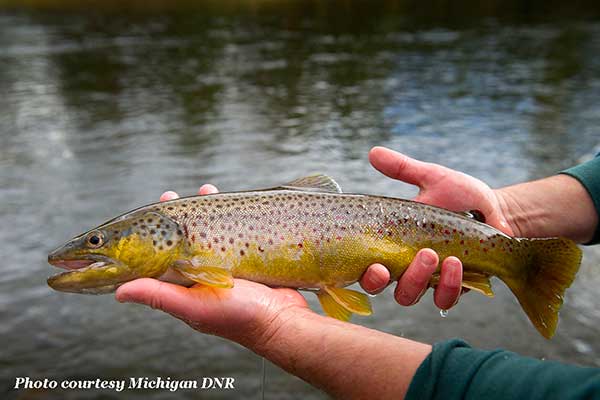- Details
(Provided by Michigan DNR)
The Department of Natural Resources this week that its Fisheries Division stocked eight different species totaling more than 1,050,000 fish that weighed more than 12.5 tons this fall. Fish were stocked at 111 different locations throughout the state.
It was another outstanding fall stocking season that will provide enhanced fishing opportunities throughout Michigan, said DNR Fish Production Manager Gary Whelan. This is in addition to our successful spring stocking efforts that put more than 19 million fish into the states waters.
The number and type of fish stocked varies by hatchery as each facilitys ability to rear fish differs because of water supplies and temperature. In Michigan, there are six state and three cooperative hatcheries that work together to produce the species, strain and size of fish needed by fisheries managers. These fish must then be delivered at a specific time and location for stocking to ensure their success. Most fish in Michigan are stocked in the spring.
- Details
As successful deer, elk and moose hunters return from trips in Michigan and beyond, the Department of Natural Resources (DNR) reminds hunters that there are regulations regarding the importation of carcasses from certain other states and provinces.
For free-ranging deer, elk or moose taken in Colorado, Illinois, Kansas, Maryland, Minnesota, Missouri, Nebraska, New Mexico, New York, North and South Dakota, Pennsylvania, Texas, Utah, Virginia, West Virginia, Wisconsin, Wyoming, Alberta and Saskatchewan, restrictions exist on parts of these animals that may be brought into Michigan.
The above states and provinces have detected chronic wasting disease (CWD) in free-ranging animals. Only the following parts of a deer, elk or moose carcass may be brought into Michigan: deboned meat, antlers, antlers attached to a skull cap cleaned of all brain and muscle tissue, hides, upper canine teeth or a finished taxidermy mount.
If you are notified by another state or province that a deer, elk or moose you brought into Michigan tested positive for CWD, you must contact the DNR Wildlife Disease Lab within two business days (8 a.m. to 5 p.m.) at 517-336-5030 and provide details.
- Details
(Provided by Michigan DNR)
 Brown TroutIs it possible that no one strain of brown trout is best for Michigans state fish hatchery system? State fisheries biologists are beginning to wonder.
Brown TroutIs it possible that no one strain of brown trout is best for Michigans state fish hatchery system? State fisheries biologists are beginning to wonder.
A four-year research project that compares two strains of brown trout that have been stocked in a pair of rivers, a handful of inland lakes and four Lake Michigan ports, is heading into the homestretch and is preliminarily showing that neither strain is best in all situations, according to Department of Natural Resources (DNR) research biologist Todd Wills.
The DNR Fisheries Division has long used Wild Rose-strain brown trout for stocking across the state. Fisheries officials have become concerned about diminishing returns from the stockings of the Wild Rose strain, which has been in the system for many years.
- Details
(Provided by Michigan DNR)
With Michigans rich tradition of fall hunting getting under way, Michigans Conservation Officers offer their top 10 tips for a safe outdoor experience.
Hunting in Michigan is a time-honored activity, rich in tradition, when families and friends come together to enjoy our great outdoors, said Lt. Andrew Turner, who leads the DNR's Recreation, Safety and Enforcement Section for the Law Enforcement Division. Making your hunt a safe and responsible experience is key to having an enjoyable and memorable time. By following these safety tips, hunters can help us all have a good season.
- Details
(Provided by Michigan DNR)
 Osprey Like Football Too!Michigan residents aren't the only ones enjoying football this fall. It turns out that osprey in northern Michigan like football, too football lights, that is.
Osprey Like Football Too!Michigan residents aren't the only ones enjoying football this fall. It turns out that osprey in northern Michigan like football, too football lights, that is.
Marion High School sits just outside of town, overlooking agricultural fields and Middle Branch River, which with its many feeder streams winds its way through the Osceola County countryside. A large mill pond near town holds a nice supply of fish.
The osprey will drop fish right on the football field, laughed Beth Robb, the Marion High School principal.


